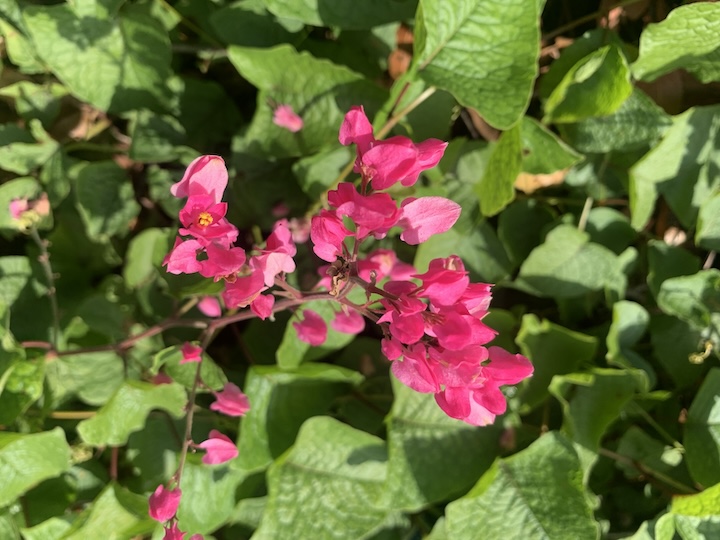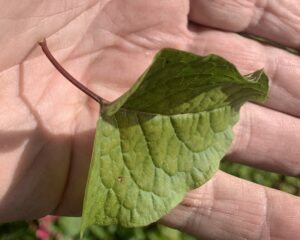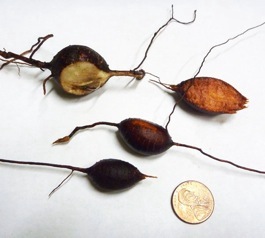
Coral Vine is not a slow creeper. Photo by Green Deane.
Antigonon leptopus: Creeping Cuisine
The Antigonon leptopus ( an-TIG-oh-non LEP-toh-puss) inspires local names everywhere it grows: Tallahassee Vine, Honolulu Creeper, the Christmas Island Crawler, as well as Confederate Vine, Mexican Coral Vine, Mexican Creeper, Chinese Love Vine, Chain of Love, Queen’s Jewels, Desert Bleeding Heart, and Queen’s Wreath. Other names include: Kadena de Amor, Flor de San Diego, Rosa de Mayo, Corona de Reina, Hierba de Santa Rosa, San Miguelito, and Fulmina. Natives called it Coamecate, Coamecatl, Chak lol makal, Cuamécatl, Gui-bakushu, Mamasa-sai and Tunuc. It’s also called the Rose of Montana, but does not grow there. In most countries where bellies are full, it’s called an invasive weed.

Antigonon leptopus has a long stem. Photo by Green Deane
Related to the seagrape and in the buckwheat family, the Coral Vine is a native of Mexico and is widely cultivated in South America. In other pan tropical places it is an escaped ornamental. It tolerates poor soil and a variety of light conditions. While a hungry man would view that as a reliable food source, most first-world governments think of it as difficult to eradicate. In Florida, where it is naturalized, it is considered a Category II invasive exotic (I have often wondered why they don’t think the same way about non-native citrus.)
A fast-growing climber, the Coral Vine grabs via tendrils and can reach 40 feet in length in old age. Its leaves are heart shaped, sometimes triangular, crinkly edged, with reticulated veins (looks wrinkled.) They are officially around one three inches long though I think they grow larger. The flowers are arranged in panicles, pink to white, blooming from spring to fall, many times year around. It is an evergreen in some climates or looses its leaves for a little while in other areas.
The Coral Vine is well-equipped to proliferate itself. It produces a huge amount of seeds, which also float. The edible seeds, and or other parts of the vine, are favored by birds, raccoon, deer, pigs and sheep. Bees and butterflies like it because least least 41.6% of its flowers are open at a given time. The plant can also reproduce via its edible tuber which grows larger with age. It likes pinewoods, fence rows, yards, disturbed ground even marshy areas. Climbing by tendrils, it tends to smother what it ascends.
Least you think the Coral Vine is just another pretty invader it’s medicinal as well. An extract of its leaves and flowers inhibit lipid peroxidation. It’s an antioxidant, anti-inflammatory and analgesic. A hot tea made from the aerial parts is used to relieve symptoms of the cold and flu. A leaf tea is also made to treat diabetes and high blood pressure. In the kitchen the cooked roots are nutty, and the leaves and flowers are dipped in flour, fried and served with pasta. The flowers are also mixed into omelet. The seeds can be roasted, winnowed, then ground and used like flour.
Antigonon is from Greek and means opposite angle, think elbow, a reference to the blossom arrangement. Leptopus is a Greek/Latin mess that comes from the Greek word Leptos meaning thin or delicate. Lepta is pocket change and lepto is a moment. If you prefer the Greek the pronunciation would be LEP-toh-puss (as in cat.) The Latin would favor lep-TOE-puss. There are four to eight species of Antigonon — depending on who is counting. A second one grows in south Florida, A. guatemalense. It has larger leaves and hairy stems. Its edibility is unknown to me.
The vine is found throughout the southern United States, Central America and South America. It is also found on Africa — it got to Egypt by 1805 — and 98% of the Pacific Islands including American Samoa, the Commonwealth of the Northern Mariana Islands, Cook Islands, Federated States of Micronesia, Fiji, French Polynesia, Galapagos Islands, Guam, Hawai‘i, Kiribati, Marshall Islands, Midway Island, Nauru, Niue, Palau, Papua New Guinea, Pitcairn Island, Samoa, Tonga, the Philippines. It is also found on most islands in the Caribbean. It can be grown as an annual or a container plant at least as far north as St. Louis. It is also found in India, Australia, and England, and is known to grow in southern California but not blossom there.
Green Deane’s “Itemized” Plant Profile
IDENTIFICATION: A twining vine, clings and climbs with curled tendrils to 40 feet. Leaves: ovate, heart-shaped, soft, pronounced veins on underside, reticulated on top. Flowers: on branch terminals, reddish or light pink, or white. Petioles 2cm or longer, whereas on the A. guatemalense they are 1 cm or shorter.
TIME OF YEAR: Roots anytime they are large enough to harvest, often deep. Blossom when in season, in warm areas nearly year round, in cooler areas until frost.
ENVIRONMENT: Nearly any environment will do. Flourishes with good water and plenty of sun
METHOD OF PREPARATION: Roots cooked — some say raw, I do not personally know that — seeds roasted and winnowed. Flowers and leaves cooked.
HERB BLURB
Tea prepared from the aerial parts of Antigonon leptopus is used as a remedy for cold and pain relief in many countries. In this study, A. leptopus tea, prepared from the dried aerial parts, was evaluated for lipid peroxidation (LPO) and cyclooxygenase (COX-1 and COX-2) enzyme inhibitory activities. The tea as a dried extract inhibited LPO, COX-1 and COX-2 enzymes by 78%, 38% and 89%, respectively, at 100 microg/ml. Bioassay-guided fractionation of the extract yielded a selective COX-2 enzyme inhibitory phenolic aldehyde, 2,3,4-trihydroxy benzaldehyde. Also, it showed LPO inhibitory activity by 68.3% at 6.25 microg/ml. Therefore, we have studied other hydroxy benzaldehydes and their methoxy analogs for LPO, COX-1 and COX-2 enzymes inhibitory activities and found that compound 1 gave the highest COX-2 enzyme inhibitory activity as indicated by a 50% inhibitory concentration (IC(50)) at 9.7 microg/ml. The analogs showed only marginal LPO activity at 6.25 microg/ml. The hydroxy analogs 6, 7 and 9 showed 55%, 61% and 43% of COX-2 inhibition at 100 microg/ml. However, hydroxy benzaldehydes 3 and 12 showed selective COX-1 inhibition while compounds 4 and 10 gave little or no COX-2 enzyme inhibition at 100 microg/ml. At the same concentration, compounds 14, 21 and 22 inhibited COX-1 by 83, 85 and 70%, respectively. Similarly, compounds 18, 19 and 23 inhibited COX-2 by 68%, 72% and 70%, at 100 microg/ml. This is the first report on the isolation of compound 1 from A. leptopus tea with selective COX-2 enzyme and LPO inhibitory activities.
Bioactive Natural Products and Phytoceuticals, 173 National Food Safety and Toxicology Center, Michigan State University, East Lansing, MI, USA. nairm@msu.edu.



Its actually not terribly surprising that the seeds are edible, as it is distantly related to buckwheat. Its interesting though that it has tubers, sounds alittle like Kudzu-light. Still as you say if you’re hungry its a great plant to have around.
Sounds like a cook could blanch leaves and make a nice soup.
Thanks for this article in Jamaica we just call it the Cold bush due to the effects on the common cold, and bees do love it I’ve never had to feed my bees, but it would be interesting to know if any of the beneficial compounds are in the honey produced by those bees.
I never knew this wonderfully exotic “weed” is edible. But whatever makes it a weed!
Hi, My wife and I conduct a small mail order plant service in Australia and I am something of a collector of climbing plants, Hoya and Rare and Hard to find plants. My question is do you have any information on Antigonon guatamolense, A. amabile and A. leptopus Baja Red?
I have been trying to produce plant of Antigonon guatamolense and A. amabile but have had touble getting the information for my plant labels.
I am also looking to purchase A. Baja Red for my collection, I know this not related to cooking but if ypu can put me on the right path it would be appreciated. Kind Regards, Wes
Hello Wes,
I was reading your message as I have been trying unsuccessfully to purchase either plants or seeds of the described white antigonon leptopus. I have only found seeds in USA and unsure whether I could order them given the description of an invasive weed. Do you know of any source in Australia?
Hi Kay Turner, I do have an Antigonon leptopus alba but as yet unpropagated. We grow all our vines by cutting so as to ensure the correct species.
Our webpage is in the process of being updated but you can still take a look and if you wish to the contact details are there.
I purchased the white and pink coral vine online from Almost Eden and they arrived yesterday…beautiful, healthy plants arrived safely. The website is http://www.almostedenplants.com
I want to buy a tuber. I live in San Diego, CA Please contact me.
I disagree with your comment that this vine doesn’t flower in Southern California. It very definitely does! I was interested enough to buy one when I saw how vigorously it bloomed and how much the bees loved it.
I too live in Southern California.
In San Diego to be exact. My vine has been in the ground for more than 30 years and yes, mine never hardly STOPS blooming. It is on or against a chain link fence and is about 40 feet long. Yellow flowers with tons of bees. It does tend to take over other plants and trees unless they are cut back.
My orange tree is an example.
Everyone that lives around me loves it and wants some for their fences. They don’t care if it is considered a weed or is invasive. It does take off in the summer months.
Take care, Bill
In St. Martin they call this coralita.
In Antigua we pronounce and call it curlitas, but close enough to your name. This vine is takes over your yard and can be very disgusting, but after reading this article I see a positive side to it. They are a big problem in my yard, just today I was in the garden digging them out. That seems to be the only was to get rid of them. My fence has been destroyed by them.
Can you please tell me in what way it destroyed your fence, I put a 3 ft cement retaining wall and a six ft fence on top abd very curious how the plant will effect it, thank you
** and, ** affect
I dug up some of these with fairly large tubers. I pressure-cooked them because they were so hard. They were inedible, in my opinion. I’m going to try again with some newly-dug ones to see if they’re better.
I harvested the seeds and tried to roast them within the hulls and I tried again even after de-hulling. They are very astringent although they have a pleasant smell when cooked. I tried to “pop” them like the article stated the Baja people did, as well as how buckwheat can be prepared but was unsuccessful. Any input Green Dean?
Its the most invasive weed I have ever come across. Unless you want your whole property covered by this weed don’t plant it, you will never get rid of it ever.
Just start honey farming in my wellness resort,bees are regular,as flowers all year around,can anybody,can advise the honey produce by bees,carry any healthy compounds from the coral vine flowers?
We had this vine growing in my yard in central Florida when I was a kid, and I always loved it. So did the bumblebees and butterflies – it may be invasive, but the native wildlife adores it. I never knew this beautiful vine was also edible and medicinal!
We have coral vine in Ghana. Though very evasive, I never knew it has medicinal properties. Please how is the leaf tea prepared?
Should i dry the green leaf and use or use the dried brown leaf?
I know it’s a while ago, but I’m reading your questions and rolling on the ground. Not because of you personally, but because I live in the caribbean and we have some properties and this vine is big trouble. It has taken over the island. I spent 3 months to take out about 100kg of tubers to clear a terrain of them. Otherwise the will not stop regrowing. If this plant is edible as I read here, no one on Curacao should be hungry. So to your questions:
– Will they grow laterally on fence and not outward? Yes, but they will not stop there 🙂 They will grow in any direction vertically, horizontally and upside down. If there exists another dimension be assured they will grow into that too.
– Do they easily attach to the fence? Yes. But you will also never get them to detach, and not only from fences..from everything, including anti-matter.
– Why are they labeled invasive? Yes, because in just one rainy month you can use a few plant to cover up and camouflage a large military base.
– When do they die back? Yes, never (unless you remove all tubers and seeds…so, never)
– And, do they upwards? How high? Yes and Yes, the second question is the one the Coral Vine will ask you…how high you want we to grow? Here in Curacao, most buildings are restricted to 3 stories…so at least that high… 🙂
I too live in Southern California.
In San Diego to be exact. My vine has been in the ground for more than 30 years and yes, mine never hardly STOPS blooming. It is on or against a chain link fence and is about 40 feet long. Yellow flowers with tons of bees. It does tend to take over other plants and trees unless they are cut back.
My orange tree is an example.
Everyone that lives around me loves it and wants some for their fences. They don’t care if it is considered a weed or is invasive. It does take off in the summer months.
Take care, Bill